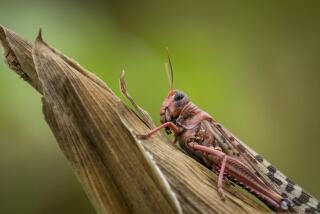Scientists discover why locusts gang up
- Share via
Desert locusts are normally solitary individuals who eke out a meager subsistence while avoiding others of their species. But when food sources become abundant, such as after a rain, they transform into ravening packs of billions of insects that can strip a landscape bare.
The key to the transformation, researchers said Friday, is the brain chemical serotonin, the chemical that in humans modulates anger, aggression, mood, appetite, sexuality and a host of other behaviors.
The locusts swarm when contact with one another triples their serotonin levels, British and Australian researchers reported in the journal Science.
The discovery “harbors considerable potential” for finding ways to prevent swarms, wrote entomologist Paul Anthony Stevenson of Leipzig University in an editorial accompanying the paper, although scientists agree that will require a great deal more research. Such a breakthrough would have a major economic impact because the insects affect about 20% of the Earth’s land surface, especially in Africa and China.
A team led by entomologist Michael L. Anstey of the University of Oxford began by looking for chemical differences between swarming and solitary locusts. The researchers found the higher levels in the swarming insects, which also turn from green to brown.
In separate experiments, they found that injecting serotonin into the insects increased swarming, and injecting serotonin blockers prevented it. Finally, injecting chemicals that raised serotonin production also increased swarming.
Blocking swarming in nature, however, is not as simple as applying serotonin blockers -- humans and most other species also rely on the chemicals. But the teams hope they can find a blocker that is specific to locusts, turning the marauders back into shy loners.
--






